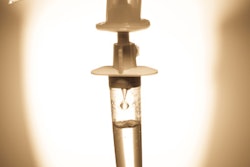
When patients walk into the office already in moderate to severe pain, their duress heightens the need for an effective anesthetic prior to treatment. Given the successful pain management of acetaminophen and hydrocodone, could preoperatively administering them increase the effectiveness of an inferior alveolar nerve (IAN) block?
Researchers from private practices and the Ohio State University College of Dentistry tested the efficacy of this approach when treating patients experiencing moderate to severe pain who were diagnosed with symptomatic irreversible pulpitis of a mandibular posterior tooth in a new study published in the Journal of Endodontics (January 2014, Vol. 40:1, pp. 1-5).
For symptomatic irreversible pulpitis, some studies have explored using preoperative ibuprofen and found increased IAN block success. But preoperative acetaminophen and hydrocodone are unlikely to have the same results, according to this latest prospective, randomized, double-blind, placebo-controlled study.
"A combination dose of 1000-mg acetaminophen/10-mg hydrocodone given 60 minutes before the administration of the IAN block did not result in a statistically significant increase in anesthetic success for mandibular posterior teeth in patients experiencing symptomatic irreversible pulpitis," the researchers wrote. But there was slightly more patient satisfaction reported in the acetaminophen/hydrocodone group.
The researchers were motivated, in part, by previous proposals suggesting that the administration of nonsteroidal anti-inflammatory drugs (NSAIDs) one hour before IAN block anesthesia could increase the likelihood of success. To date, there have not been any studies examining the efficacy of this approach when treating posterior teeth in patients with symptomatic irreversible pulpitis.
In all, 100 emergency patients at the College of Dentistry participated in the study; none was younger than 18, had a history of significant health issues, took depressants or analgesic medications less than 6 hours before participating, or was pregnant. The participants also had a vital mandibular posterior tooth, had moderate to severe pain, and a prolonged response to tetrafluoroethane cold testing.
Having met the clinical diagnosis for symptomatic irreversible pulpitis, the patients rated their anxiety on Corah's Dental Anxiety Scale. They also rated their initial pain on a Heft-Parker visual analog scale (VAS), which has descriptors along the scale instead of a simple 0 to 100 range.
One hour before receiving an IAN block, half of the patients ingested acetaminophen/hydrocodone, while the other half ingested a placebo. "We believed the timing of preoperative medication and endodontic treatment was appropriate," the researchers wrote. Each patient was assigned a six-digit number corresponding to the medication they were given; the researchers (except for the lead researcher) and patients were not told what numbers corresponded to which medication to blind the study.
When 60 minutes had passed, the patients received benzocaine at the IAN block site before receiving a standard IAN block injection, all performed by the same administrator. Then the patient was questioned about lip numbness at one-minute intervals for 15 minutes. In nine patients (four in the acetaminophen/hydrocodone group and five in the placebo group), no numbness was reported after 15 minutes, and they received another cartridge of lidocaine and epinephrine.
Next, the researchers isolated the teeth and performed endodontic access; if patients signaled that they felt pain, the procedure was halted and the pain experience rated on the Heft-Parker VAS. Success was defined as no pain or mild pain with a VAS rating of 54 mm or less while cleaning and shaping the tooth. Patients who still felt moderate or severe pain received more treatment for their pain until the clinicians could proceed.
The researchers found that, "except for the effects of the medications, there were no significant differences between the combination acetaminophen/hydrocodone and placebo groups." IAN block success was recorded in 32% of the acetaminophen/hydrocodone group and 28% of the placebo group (p = 0.66). The patient characteristics of age, initial pain, gender, anxiety, tooth type, and food intake did not lead to statistically significant differences in response, either.
However, while 2% and 6% of the placebo group patients were "not satisfied" or "somewhat satisfied," respectively, all patients in the other group were at least "moderately" or "completely satisfied." While 38% of the placebo group was "completely satisfied," 48% of the acetaminophen group reported this way. The euphoria that patients may have felt from the opioid medication could have contributed to the more favorable response.
Ultimately, the researchers acknowledged that while "opioid analgesics are effective against constant dull, aching pain, they may not be effective during acute pain at a site of previous/concurrent inflammation."



















